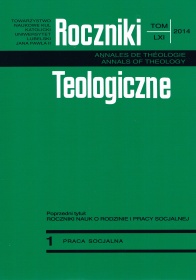Forming Oneself of Aid Institutions in Poland to 1990
Abstract
Assistance activities took different forms and has evolved from a long time and took different forms: fraternal assistance, philanthropy, charity, organized assistance. The first institutionalized forms of assistance to the poor and needy are associated with the Catholic Church assistance. Hospitals were the first aid institutions, which were run by religious communities. Developing ecclesial communities followed the Council of Trent. Governments began to create the structure of aid institution in the fourteenth century. The seventeenth and eighteenth century was the best time of charitable activities in Poland and after that Polish partitions then stopped the development of charity in Poland. The revival of the church and charitable activities of lay people was between nineteenth and twentieth centuries. Activities of social organizations in Poland were banned during the German occupation. The only legal organization was The Main Social Council. Many religious and secular aid organizations was reactivated after the second world war. In the Stalinist period (1948-1956) there was a total destruction of the social welfare system. In 1957-1972 was revising the approach to social problems. The period of 1990 was a crucial year, when Parliament passed the law on social assistance. Then have been set up welfare centers as the primary specialized local government. The next step was the process of creating a system-intensive institutions and non-governmental organizations.
References
Dola K., Opieka społeczna Kościoła, w: B. Kumor, Z. Obertyński (red.), Historia Kościoła w Polsce, t.1, Poznań–Warszawa: Pallottinum 1974.
Góra W. A., Tradycje opieki i pomocy społecznej w Polsce, „Praca Socjalna” 1989, nr 2, s. 22-35.
Kuźmak K., Bractwo kościelne, w: Encyklopedia katolicka, t. 2, Lublin 1973, kol. 1013.
Leś E., Zarys historii dobroczynności i filantropii w Polsce, Warszawa: Prószyński i S-ka 2001.
Majka J., Kościelna działalność dobroczynna w Polsce w XIX i w pierwszej połowie XX w., w: Księga 1000-lecia katolicyzmu w Polsce, cz. 3, Lublin 1969.
Oleszczyńska A., Z historii pomocy społecznej oraz kształcenia pracowników socjalnych, „Opiekun Społeczny” 1978, nr 4.
Plis J., Z dziejów kościelnej działalności charytatywnej w Polsce przedrozbiorowej, w: A. Mieczkowski (red.), Dzieła miłosierdzia chrześcijańskiego w Polsce i archidiecezji lubelskiej, Lublin: Norbertinum 1997.
Strzeszewski Cz., Chrześcijańska myśl i działalność społeczna w zaborze pruskim w latach 1865-1918, w: Cz. Strzeszewski, R. Bender, K.Turowski (red.), Historia katolicyzmu społecznego w Polsce 1832-1935, Warszawa: Ośrodek Dokumentacji i Studiów Społecznych 1981, s. 112-115.
Styk J., Dzieło miłosierdzia chrześcijańskiego w diecezji lubelskiej w XIX i XX wieku, w: A. Mieczkowski (red.), Dzieła miłosierdzia chrześcijańskiego w Polsce i archidiecezji lubelskiej, Lublin: Norbertinum 1997, s. 90-91.
Copyright (c) 2014 Roczniki Teologiczne

This work is licensed under a Creative Commons Attribution-NonCommercial-NoDerivatives 4.0 International License.





